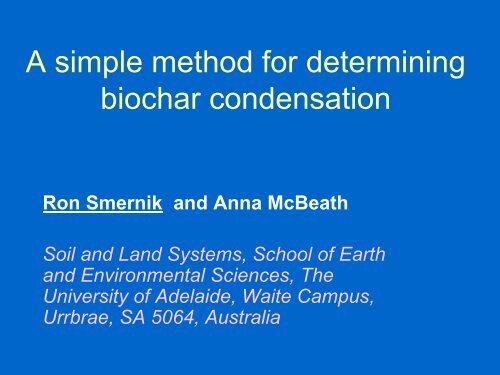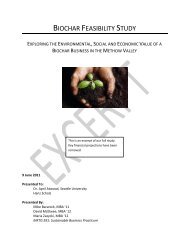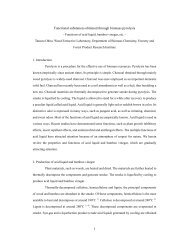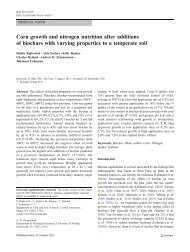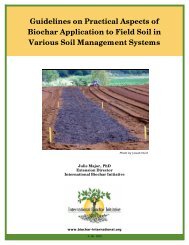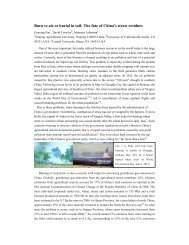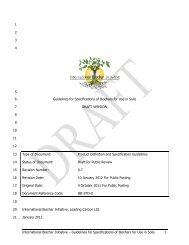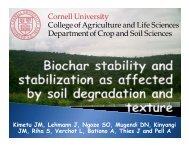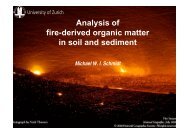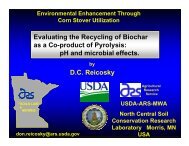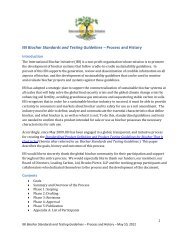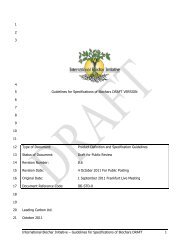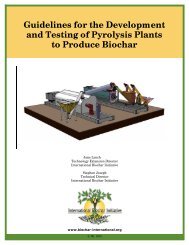A simple method for determining biochar condensation
A simple method for determining biochar condensation
A simple method for determining biochar condensation
You also want an ePaper? Increase the reach of your titles
YUMPU automatically turns print PDFs into web optimized ePapers that Google loves.
A <strong>simple</strong> <strong>method</strong> <strong>for</strong> <strong>determining</strong><br />
<strong>biochar</strong> <strong>condensation</strong><br />
Ron Smernik and Anna McBeath<br />
Soil and Land Systems, School of Earth<br />
and Environmental Sciences, The<br />
University of Adelaide, Waite Campus,<br />
Urrbrae, SA 5064, Australia
What does “<strong>biochar</strong> <strong>condensation</strong>” mean?<br />
The chemical structure of <strong>biochar</strong> is very distinctive<br />
Consists predominantly of fused aromatic rings<br />
Basic unit is benzene – the <strong>simple</strong>st<br />
aromatic molecule<br />
• Planar<br />
• Chemically stable<br />
• Clear colourless liquid<br />
In <strong>biochar</strong>, “many” of these benzene<br />
rings are fused together<br />
• Planar<br />
• Stable (to chemical and<br />
biological breakdown)<br />
• Black solid
What does “<strong>biochar</strong> <strong>condensation</strong>” mean?<br />
The chemical structure of <strong>biochar</strong> is very distinctive<br />
Consists predominantly of fused aromatic rings<br />
Graphite is the ultimate in fused<br />
aromatic structures<br />
• Essentially infinite planar 2D<br />
sheets<br />
• Stacked in 3 rd dimension<br />
Chemically very stable<br />
• Black solid (metallic sheen)
What does “<strong>biochar</strong> <strong>condensation</strong>” mean?<br />
In <strong>biochar</strong> fused aromatic ring systems are of finite size and contain<br />
impurities (other atoms e.g. O, N, functional groups, radicals, holes)
How large and pure (condensed) are the<br />
fused aromatic structures in <strong>biochar</strong>?<br />
Varies with production conditions<br />
• Heat treatment temperature<br />
We don’t really know!
How large and pure (condensed) are the<br />
fused aromatic structures in <strong>biochar</strong>?<br />
We don’t really know!<br />
Varies with production conditions<br />
• Heat treatment temperature<br />
• Heating time<br />
• Starting material (wood, manure etc.)<br />
These are only “representative structures” (best guesses)
Why is <strong>biochar</strong> <strong>condensation</strong> important?<br />
The unique properties of <strong>biochar</strong> relate to its chemical structure<br />
The expectation is that more condensed (graphitic) <strong>biochar</strong>s:<br />
• are more inert (better C storage)<br />
• are more slowly functionalized (take longer to develop Terra Preta<br />
properties)<br />
We need to be able to measure <strong>biochar</strong> <strong>condensation</strong> to:<br />
• classify <strong>biochar</strong>s<br />
• predict the lifetime of C in soil <strong>for</strong> different <strong>biochar</strong>s<br />
• predict long-term fertility benefits of different <strong>biochar</strong>s<br />
• follow changes that occur to charcoal chemistry over time<br />
Where on this continuum<br />
does a given <strong>biochar</strong> lie,<br />
and how will that change<br />
over time?
Measuring <strong>biochar</strong> <strong>condensation</strong><br />
Many techniques have been used to characterize <strong>biochar</strong> – none<br />
provide a direct measure of <strong>condensation</strong><br />
We have developed such a <strong>method</strong> – it uses NMR spectroscopy and is<br />
based on “ring currents” that are produced in condensed aromatic<br />
structures
“Standard” NMR spectroscopy<br />
NMR spectroscopy is widely used to determine the aromatic C content<br />
of <strong>biochar</strong>s<br />
250°C <strong>biochar</strong><br />
Very Little<br />
aromatic C<br />
450°C <strong>biochar</strong><br />
Mostly<br />
aromatic C<br />
Very little change<br />
once the majority of C<br />
is aromatic<br />
Not sensitive to<br />
<strong>biochar</strong> <strong>condensation</strong><br />
850°C <strong>biochar</strong><br />
Virtually all<br />
aromatic C<br />
Wood <strong>biochar</strong>s – different temps<br />
Different starting materials 500-600°C
What is a ring current?<br />
Electrons are free to move in aromatic rings<br />
In the presence of an external magnetic field, they circulate, and this<br />
induces a localized, weak magnetic field near the ring<br />
Larger and purer (more condensed) ring systems produce larger ring<br />
currents and stronger magnetic fields<br />
NMR differentiates atoms based on slight differences in magnetic field<br />
due to “shielding” by electrons (chemical shift)<br />
Ring currents effects are superimposed on chemical shift effects
How to measure these ring currents<br />
13<br />
C-Benzene<br />
δ=128.7 ppm<br />
sample<br />
probe<br />
molecule<br />
solid-state 13 C NMR<br />
spectrometer
How to measure these ring currents<br />
By using a 13 C-labelled probe molecule we ensure most NMR signal<br />
(which comes from only 13 C nuclei) is from the probe molecule<br />
Only ~1% of carbon in the <strong>biochar</strong> is 13 C (natural abundance)<br />
Biochar (200 mg) +<br />
13<br />
C-benzene (10 mg)<br />
Biochar alone
The output<br />
In the absence of ring currents, 13 C-benzene gives a peak at 128.7 ppm.<br />
Ring currents shift that peak to lower values when sorbed to <strong>biochar</strong><br />
Expressed as Δδ – i.e. the difference from 128.7 ppm<br />
Wood 250<br />
Δδ ‐0.3<br />
Wood 450<br />
Δδ ‐1.5<br />
Wood 850<br />
Δδ ‐8.1<br />
Grass 250<br />
Δδ ‐0.1<br />
Grass 450<br />
Δδ ‐1.1<br />
Grass 850<br />
Δδ ‐6.5<br />
Lab-produced<br />
<strong>biochar</strong>s – long<br />
heating times (~2h)<br />
Clear effect of<br />
production<br />
temperature – more<br />
negative Δδ values<br />
<strong>for</strong> higher temps<br />
(more condensed)<br />
Smaller effect of<br />
starting material –<br />
wood <strong>biochar</strong>s more<br />
condensed than<br />
grass <strong>biochar</strong>s<br />
Δδ ‐0.7<br />
Δδ ‐1.5<br />
Δδ ‐1.6<br />
Δδ ‐0.5<br />
Δδ ‐0.3<br />
Δδ ‐3.8<br />
Cow manure<br />
500°C<br />
Green waste<br />
500°C<br />
Green waste<br />
600°C<br />
Papermill waste<br />
500°C<br />
Poultry litter<br />
500°C<br />
Rice husks<br />
???°C<br />
Fast pyrolysis<br />
<strong>biochar</strong>s –<br />
shorter heating<br />
times<br />
Generally less<br />
negative Δδ values<br />
<strong>for</strong> given temps<br />
High ash <strong>biochar</strong>s<br />
have lower<br />
<strong>condensation</strong><br />
Rice husk char<br />
(production temp<br />
unknown)<br />
substantially more<br />
condensed
The output<br />
In the absence of ring currents, 13 C-benzene gives a peak at 128.7 ppm.<br />
Ring currents shift that peak to lower values when sorbed to <strong>biochar</strong><br />
Expressed as Δδ – i.e. the difference from 128.7 ppm<br />
Activated<br />
<strong>biochar</strong>s<br />
G<br />
Δδ ‐1.8<br />
Natural<br />
<strong>biochar</strong>s –from a<br />
bushfire<br />
Δδ ‐10.0<br />
Δδ ‐6.5<br />
Highly condensed<br />
structures (very<br />
negative Δδ values)<br />
Commercial<br />
activated carbon<br />
(AC1) more<br />
condensed than<br />
activated cow<br />
manure <strong>biochar</strong><br />
(AC2)<br />
OW<br />
Δδ ‐2.0<br />
PB<br />
Δδ ‐1.1<br />
EW1<br />
Δδ ‐2.0<br />
EW2<br />
Δδ ‐2.8<br />
Effect of starting<br />
material – wood<br />
<strong>biochar</strong>s (OW, EW)<br />
more condensed<br />
than grass <strong>biochar</strong><br />
(G) and bark<br />
<strong>biochar</strong> (PB)<br />
“Apparent”<br />
production<br />
temperature ~500-<br />
600°C <strong>for</strong> wood<br />
<strong>biochar</strong>s
Summary of findings so far<br />
• Biochar <strong>condensation</strong> increases with production temp<br />
• Influenced by starting material (woody materials give most condensed chars)<br />
• Provides a measure <strong>for</strong> <strong>biochar</strong>s produced at unknown temps<br />
• Very old (Terra Preta type) <strong>biochar</strong> gives Δδ ~ 0 – technique is<br />
sensitive to aging effects<br />
• Minimal effects on aging in soil <strong>for</strong> ~ 1 year<br />
• Soot has surprisingly low degree of <strong>condensation</strong>
Potential of the technique<br />
• Decomposability index <strong>for</strong> fresh <strong>biochar</strong><br />
• Measure of production temp <strong>for</strong> natural chars<br />
• Measure of changes to <strong>biochar</strong> surfaces on aging<br />
Advantages<br />
• No other technique provides such a direct measure of this parameter<br />
• Simple procedure, no pre-treatment<br />
• Relatively inexpensive (~$100 per sample)<br />
Continuing research<br />
• Detailed temperature scale<br />
• Temperature – time matrix<br />
• Effects of aging – lab, field incubation; old chars (decades-centuries)<br />
• Mechanisms of decrease in Δδ (surface oxidation, interaction with minerals, organics)
A <strong>simple</strong> <strong>method</strong> <strong>for</strong> <strong>determining</strong><br />
<strong>biochar</strong> <strong>condensation</strong><br />
Ron Smernik and Anna McBeath<br />
Soil and Land Systems, School of Earth<br />
and Environmental Sciences, The<br />
University of Adelaide, Waite Campus,<br />
Urrbrae, SA 5064, Australia
1 st Asia Pacific Biochar Conference<br />
Gold Coast, 17-20 May 2009<br />
Rick Davies<br />
Japanese Biochar<br />
Association


